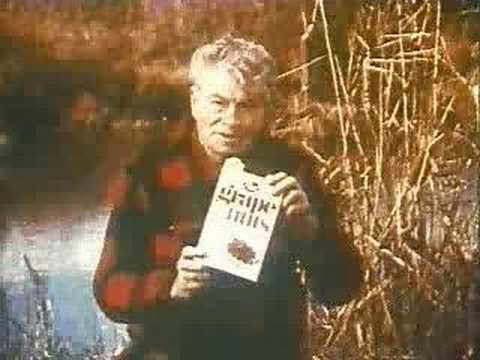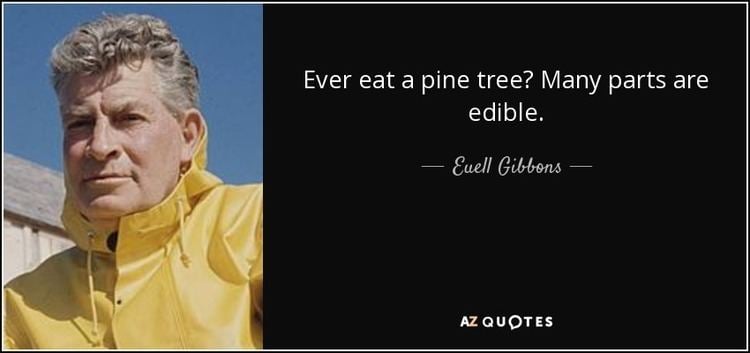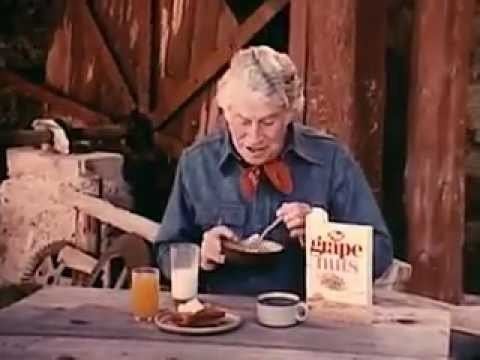Name Euell Gibbons | Spouse Freda Fryer (m. 1949) | |
 | ||
Died December 29, 1975, Selinsgrove, Pennsylvania, United States Books Stalking the wild asparagus, Stalking the healthful, Stalking the blue‑eye, Feast on a Diabetic Diet, Euell Gibbons' Beachco | ||
Euell gibbons for grape nuts fixed sound
Euell Theophilus Gibbons (September 8, 1911 – December 29, 1975) was an outdoorsman and proponent of natural diets during the 1960s.
Contents
- Euell gibbons for grape nuts fixed sound
- Match game 75 who s euell gibbons
- Early career
- Literary career and celebrity
- Death
- References

Match game 75 who s euell gibbons
Early career

Gibbons was born in Clarksville, Texas, on September 8, 1911, and spent much of his youth in the hilly terrain of New Mexico. His father drifted from job to job, usually taking his family (a wife and four children) with him.

During one difficult interval of homesteading, Gibbons began foraging for local plants and berries to supplement the family diet. After leaving home at 15, he drifted throughout the Southwest, finding work as a dairyman, carpenter, trapper, gold panner, and cowboy. The early years of the Dust Bowl era found Gibbons in California, where he lived as a self-described “bindle stiff” (hobo) and, in sympathy with labor causes, began writing Communist Party leaflets. Later in the 1930s he settled in Seattle, served a stint in the Army, married, and worked as a carpenter, surveyor, and boatbuilder.

During the late 1930s, Gibbons was still giving "more time to his political activity than to his work, and more time to wild food than to politics." After Russia invaded Poland in 1939, however, he renounced Communism and spent most of World War II in Hawaii, building and repairing boats for the Navy. His first marriage, Gibbons recalled, became a "casualty of the war," and in the postwar years he chose the life of a beachcomber on the Hawaiian Islands.

After entering the University of Hawaii as a 36-year-old freshman, Gibbons majored in anthropology and won the university's creative-writing prize. In 1948, he married Freda Fryer, a teacher, and both decided to join the Society of Friends (the Quakers), stating "I became a Quaker because it was the only group I could join without pretending to beliefs that I didn't have or concealing beliefs that I did have."
The couple relocated to the mainland in 1953, where (after a failed attempt to found a cooperative agricultural community in Indiana) Gibbons became a staff member at Pendle Hill Quaker Study Center near Philadelphia, cooking breakfast for everyone every day. Around 1960, through his wife's urging and support, he was able to follow through on his earlier aspirations and turn to writing.
Literary career and celebrity
At the urging of a New York literary agent, Gibbons agreed to rework the draft of a novel (about a schoolteacher who wows café society with opulent meals of foraged foodstuffs) into a straightforward book on wild food. Capitalizing on the growing return-to-nature movement in 1962, the resulting work, Stalking the Wild Asparagus, became an instant success. Gibbons then produced the cookbooks Stalking the Blue-Eyed Scallop in 1964 and Stalking the Healthful Herbs in 1966. He was widely published in various magazines, including two pieces which appeared in National Geographic Magazine.
The first article, in the July 1972 issue, described a two-week stay on an uninhabited island off the coast of Maine where Gibbons along with his wife Freda and a few family friends relied solely on the island's resources for sustenance. The second article, which appeared in the August 1973 issue, features Gibbons, along with granddaughter Colleen, grandson Mike, and daughter-in-law Patricia, stalking wild foods in four western states.
His publishing success brought him fame. He made guest appearances on The Tonight Show and The Sonny & Cher Comedy Hour, and was awarded an honorary doctorate from Susquehanna University. A 1974 television commercial for Post Grape-Nuts cereal featured Gibbons asking viewers "Ever eat a pine tree? Many parts are edible." While he recommended eating Grape Nuts over eating pine trees (Grape Nuts' taste "reminds me of wild hickory nuts"), the quote caught the public's imagination and fueled his celebrity status.
Johnny Carson joked about sending Gibbons a "lumber-gram", and Gibbons himself joined in the humor; when presented with a wooden award plaque by Sonny and Cher, he good-naturedly took a bite out of it. (The "plaque" was actually an edible prop.) He was satirized by John Byner on the Carol Burnett Show episode which aired October 6, 1973, shown eating tree parts. In a 1974 skit on the children's television program The Electric Company, cast member Skip Hinnant (as "Early Gibbons") was a proponent of eating items starting with the prefix "ST-," including a tree stump, a staircase (with a "first step," presumably made of wood) and sticks and stones.
Often mistaken for a survivalist, Gibbons was simply an advocate of nutritious but neglected plants. He typically prepared these not in the wild, but in the kitchen with abundant use of spices, butter and garnishes. Several of his books discuss what he called "wild parties": dinner parties where guests were served dishes prepared from plants gathered in the wild. His favorite recommendations included lamb's quarters, rose hips, young dandelion shoots, stinging nettle and cattails. He often pointed out that gardeners threw away the more tasty and healthy crop when they pulled such weeds as purslane and amaranth out from among their spinach plants.
Death
Gibbons died on December 29, 1975, aged 64, at Sunbury Community Hospital in Sunbury, Pennsylvania. His death was the result of a ruptured aortic aneurysm, a complication from Marfan syndrome.
